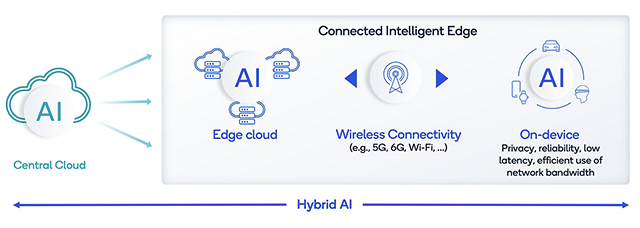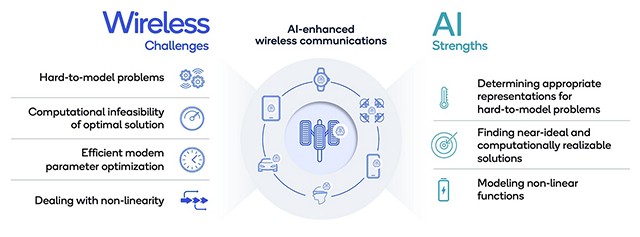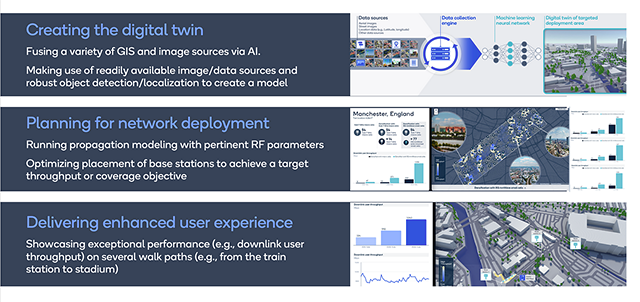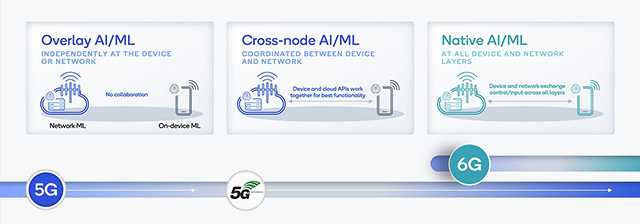Courtesy: Qualcomm
From revolutionizing industries to reshaping our daily routines, there is no denying the profound impact of Artificial Intelligence (AI), making it one of the most disruptive technologies on the horizon. Thanks to the recent surge in media attention surrounding ChatGPT, the momentum for cutting-edge AI research is reaching unprecedented heights, propelling us towards innovations that can open new possibilities. Our mission with AI is to responsibly bring its benefits to more people around the world, elevate everyday mobile experiences, and enable new efficiencies for a wide range of consumer, enterprise and industrial applications.
However, scaling AI to reach its full potential is no trivial undertaking. To do so efficiently, it’s imperative for AI processing to be intelligently distributed between the cloud and edge devices.
That’s why we believe the future of AI is hybrid. AI computation is split where and when appropriate, to provide enhanced experiences and ensure efficient use of resources.
To realize this vision, not only do we need to foster AI advances through cutting-edge research but also drive the continued wireless technology evolution. Wireless and AI are two synergistic ingredients that will fuel future innovations.
AI benefits the end-to-end wireless system
Today, 5G is propelling the rapid proliferation of intelligent devices and services, with more than 1.5B connections globally1. The rise of AI not only transforms our mobile experiences (e.g., improved camera quality, predictive texting), but also brings a unique opportunity to revolutionize the future of wireless communications.
AI’s immense potential can be harnessed to solve complex challenges in wireless system design. A testament to this is our Snapdragon Modem-RF platforms; now for two generations, we have adopted AI to enhance modem-RF system performance.
AI’s role in wireless will continue to expand. For instance, it can help optimize system energy saving, network load balancing and device mobility management. In fact, AI will touch every part of the end-to-end wireless system design. Here is a brief summary of AI’s role in each key part of the system.
- Optimized distributed clouds: AI can enable fully autonomous networks, make predictive and preventive operational optimizations on a continuous basis, and improve efficiency by reducing network loading.
- Intelligent disaggregated network: AI powers the radio access network (RAN) intelligent controller, which can more effectively manage interference, schedule transmission, and facilitate coordinate multipoint (CoMP) operations.
- AI-enabled air interface design: AI is fundamentally transforming the design and evolution of the air interface (i.e., waveform, coding), bringing new capabilities like dynamic channel adaptation, and more.
- Smart edge devices: AI can optimize device experiences with more efficient beam management and channel feedback computation, as well as enhanced capabilities like positioning and RF sensing.
Demo: Adaptive RAN operation for 5G
To showcase the benefits of wireless AI in real systems, earlier this year, we demonstrated wireless AI using our 5G test networks at our headquarters in San Diego. Watch the demos above.
AI for network deployment optimization
Additionally, AI can also be utilized to facilitate a more optimized network deployment strategy. To illustrate, we have developed:
- An intelligent network planning tool that leverages AI to first create a digital twin of the targeted deployment area, run it through a trained machine learning model, and
- Output an optimized network deployment plan based on design requirements (e.g., capacity, speed) and constraints (e.g., cost, type of infrastructure).
Our demonstration showcased how a 5G network can be flexibly designed to add mmWave extreme capacity that complements sub-7 gigahertz (GHz) wide-area coverage.
The wireless AI era starts with 5G Advanced
To get the most benefits from wireless AI, technology standardization is essential. It can define how AI is best utilized while ensuring seamless interoperability across multiple vendors in the end-to-end wireless system. 3GPP officially began the work on 5G Advanced in late 2021, setting out to study a standardized wireless AI framework and potential applications. The figure below illustrates the focus on initial use cases.
These wireless AI capabilities not only make new system efficiencies and user experiences possible, but also lay the foundation for future wireless AI innovations. At Qualcomm Technologies, we are not only actively researching wireless AI and contributing our work to technology standards, but also prototyping all use cases in our test networks. Three of our most recent wireless AI demonstrations are summarized below.
- Multi-vendor channel state feedback: We prototyped with the Qualcomm Cloud AI 100 platform and Snapdragon Modem-RF system in our 3.5 GHz massive MIMO testbed. It highlights the capacity gain in a multi-vendor system, enabled by sequential learning that prevents proprietary knowledge sharing.
- Advanced mmWave beam management: We enabled predictive beam management for both the base station and device in our 28 GHz mmWave testbed in San Diego. The implementation reduces signaling overhead resulting in increased usable capacity and extended device battery life.
- Intelligent industrial positioning: We demonstrated centimeter-level accuracy in our indoor industrial IoT testbed, overcoming the complex challenges of multipath reflections. Downlink RF fingerprinting with AI outperforms other positioning techniques, such as downlink time difference of arrival, in this challenging environment.
Onward to 6G: An AI-native communications system design
Looking beyond 5G Advanced, our vision is for 6G to be an AI-native innovation platform. 6G is expected to have a data-driven design that distributes AI throughout all protocols and layers, allowing it to continuously improve as more data is collected. Today, our research focus is on enabling efficient joint training, model sharing, and distributed inference across networks and devices, including federated learning that scales fully with 6G.
The journey with wireless AI is just beginning
We’re very excited by the potential impact that AI will have for the future of wireless communications. As 5G Advanced officially kicks start the era of wireless AI, we’ll be sharing periodic updates on the work we’re doing, whether it’s on advanced research, technology standardization, or bringing wireless AI to fruition with product support. So, stay tuned for more.














